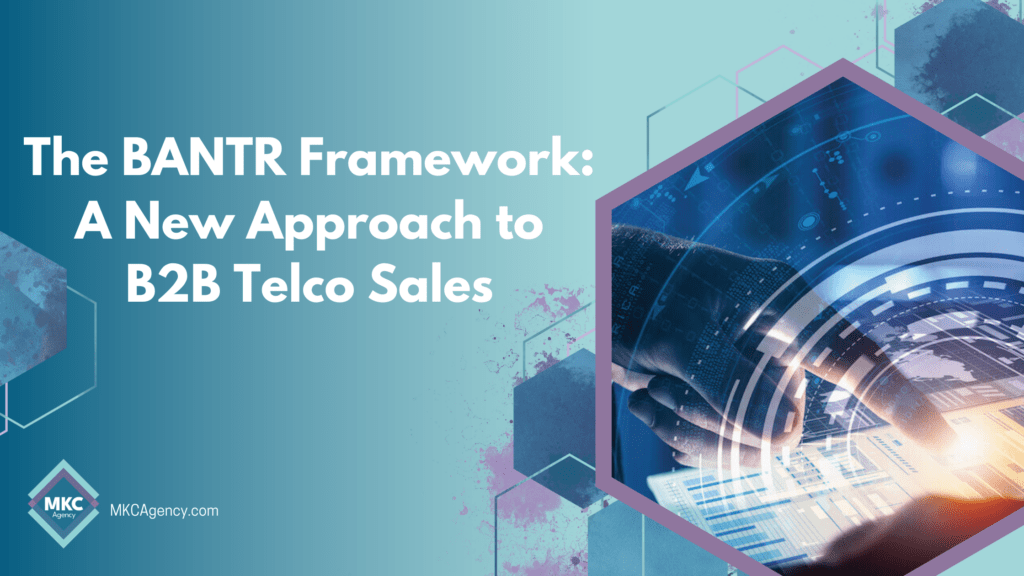Navigating the sales landscape in the B2B telecom sector can be a complex task. Traditional methods of identifying sales prospects may not be enough in today’s fast-paced, technology-driven environment. Enter BANTR, a new sales framework that takes into account the Budget, Authority, Needs, Timeline, and Risks (BANTR) of your prospective clients. Coupled with an understanding of DISC personalities, BANTR offers a comprehensive approach to B2B sales.
1. Discovering Budget:
Understanding a prospect’s financial resources is crucial. For each DISC personality, this discovery may look a little different:
-
D personalities: “What kind of budget have you allocated for a new telecom solution?”
-
I personalities: “What level of investment are you willing to make to enhance your telecommunications?”
-
S personalities: “What financial considerations should we be aware of when discussing potential solutions?”
-
C personalities: “What financial resources have you allocated for this project?”
Uncovering this information early on is critical to ensuring your solution aligns with their fiscal expectations.
2. Diffusing Budget Objections:
When budget objections arise, our focus should be on diffusing these objections, rather than overcoming them. For each DISC personality:
-
D personalities appreciate clear ROI information.
-
I personalities respond to examples of positive impact and success stories.
-
S personalities need to see the cost of inaction and the long-term financial benefits.
-
C personalities appreciate a detailed cost analysis and the cost-effectiveness of the solution.
Remember, objections are often about perceived value, not just cost.
3. Discovering Authority:
Identifying the decision-maker is crucial. Each DISC personality might reveal this in different ways:
-
D personalities: “Who, in addition to yourself, is involved in the decision-making process?”
-
I personalities: “Who else would you like to involve in this conversation?”
-
S personalities: “Who else in your team might be affected by this decision?”
-
C personalities: “Who else is a key stakeholder in this project?”
Recognizing the decision-maker early can streamline the process.
4. Diffusing Authority Objections:
When authority objections arise, diffuse them by:
-
Reinforcing the leadership role of D personalities.
-
Encouraging I personalities to share the vision with their team.
-
Assuring S personalities of the solution’s positive impact on the team.
-
Empowering C personalities with detailed information and analysis.
5. Discovering Needs:
Understanding a prospect’s needs helps to tailor your approach. Ask:
-
D personalities: “What challenges are you hoping to address with a new telecommunications solution?”
-
I personalities: “How do you see our services enhancing your operations?”
-
S personalities: “What current issues prompted you to seek a new solution?”
-
C personalities: “What specific features are you seeking in a telecom solution?”
Deep engagement helps turn latent needs into active ones.
6. Diffusing Need Objections:
Diffuse need objections by:
-
Showing D personalities how your solution tackles their challenges.
-
Painting a vivid picture for I personalities of the future with your solution.
-
Demonstrating to S personalities how your solution will provide stability and continuity.
-
Providing C personalities with detailed comparisons and assessments to showcase your solution’s merits.
7. Discovering Timeline:
Each DISC personality has different expectations for implementation:
-
D personalities: “What’s your ideal timeline for implementation?”
-
I personalities: “When would you like to start seeing results?”
-
S personalities: “What’s your timeframe for making a transition?”
-
C personalities: “What are the key milestones and dates we should be aware of?”
Understanding their timeframe helps align your solution to their expectations.
8. Diffusing Timeline Objections:
Address timeline objections by:
-
Providing D personalities with a clear roadmap.
-
Showcasing to I personalities the quick wins and long-term benefits.
-
Assuring S personalities about the support they’ll receive during the transition.
-
Offering C personalities a detailed timeline with key milestones.
9. Discovering Risk:
Understanding a prospect’s perceived risks is vital:
-
D personalities: “What potential risks are you considering?”
-
I personalities: “What are your concerns about the potential changes this investment would bring?”
-
S personalities: “What potential disruptions or challenges do you foresee?”
-
C personalities: “What are the potential drawbacks or shortcomings of our services?”
10. Diffusing Risk Objections:
Diffuse risk objections by:
-
Providing D personalities with a clear risk management roadmap.
-
Reassuring I personalities about the positive impacts.
-
Showing S personalities how change will be managed to minimize disruptions.
-
Offering C personalities detailed contingency plans and thorough risk assessments.
The BANTR framework provides a comprehensive approach to B2B sales in the telco sector. Are you ready to transform your sales process? Share your thoughts in the comments below or reach out for a consultation. Let’s unlock sales success together!

